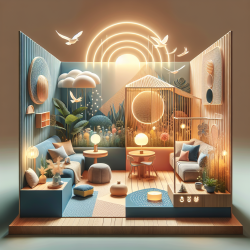Designing spaces that cater to the unique sensory needs of individuals with Autism Spectrum Disorder (ASD) is essential. These spaces not only support their daily functioning but also enhance their well-being and independence. Understanding the impact of sensory inputs on those with autism can lead to more inclusive and accommodating environments.
Understanding Autism Spectrum Disorder
Autism Spectrum Disorder is a neuro-developmental condition that affects communication, behavior, and sensory processing. Individuals with ASD may experience either hypersensitivity or hyposensitivity to sensory stimuli, which can lead to anxiety and discomfort. This is why creating environments that address these sensory challenges is crucial.
The Role of Design in Autism
Design modifications are key in managing the sensory needs of individuals with ASD. By focusing on specific sensory elements such as auditory, visual, and tactile inputs, we can create spaces that are both welcoming and functional.
Auditory Considerations
- Minimize background noise by using sound-absorbing materials like carpets and acoustic panels.
- Avoid fluorescent lighting which can emit noise; opt for natural lighting instead.
- Implement soft-close mechanisms on doors and cabinets to reduce sudden loud noises.
Sight Considerations
- Use dimmable LED lights and window treatments to control light intensity.
- Select light, warm, and neutral colors to create a soothing atmosphere.
- Avoid clutter and use visual partitions to minimize distractions.
Tactile Considerations
- Create private spaces to respect personal space and reduce unwanted touch.
- Integrate sensory walls that provide tactile feedback in a controlled manner.
- Incorporate furniture that offers comfort and protection, like high-back chairs.
Sensory Zoning and Sequencing
Sensory zoning involves organizing spaces based on their level of sensory stimulation. High-activity areas should be grouped together away from quieter zones. This helps individuals with ASD navigate their environment more effectively. Transition zones between these areas can help recalibrate their senses.
Creating Respite Rooms
Respite rooms provide a calm environment where individuals can decompress from sensory overload. These rooms should be equipped with items that offer various forms of sensory input like cushions, fiber optic lights, and sound-blocking headphones. Such spaces are essential in providing moments of peace amidst overstimulation.
Family-Friendly Facilities and Outdoor Spaces
Designing unisex or single-user facilities ensures safety and accessibility for all family members. Outdoor spaces should incorporate wide pathways, retreat areas, and wayfinding signage to accommodate the diverse needs of those with ASD. Interaction with nature has been shown to improve behavior and well-being.
By implementing these design strategies, we can create environments that not only accommodate but also empower individuals with autism. For more information on designing sensory-friendly spaces, please follow this link.










